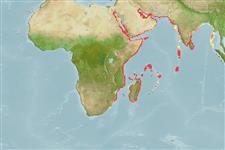Common names from other countries
Teleostei (teleosts) >
Eupercaria/misc (Various families in series Eupercaria) >
Nemipteridae (Threadfin breams, Whiptail breams)
Etymology: Scolopsis: Greek, skolex = worm + Greek, opsis = appearance (Ref. 45335).
Environment: milieu / climate zone / depth range / distribution range
Ecology
Marine; reef-associated; depth range 1 - 20 m (Ref. 9710). Tropical; 31°N - 33°S, 31°E - 95°E (Ref. 3810)
Indian Ocean: Red Sea, Persian Gulf, Gulf of Oman and East Africa (up to Delagoa Bay) to Madagascar and the Andaman Islands.
Size / Weight / Age
Maturity: Lm ? range ? - ? cm
Max length : 30.0 cm TL male/unsexed; (Ref. 30573); common length : 12.0 cm SL male/unsexed; (Ref. 3810)
Dorsal
spines
(total): 10;
Dorsal
soft rays
(total): 9;
Anal
spines: 3;
Anal
soft rays: 7. Head scales reaching forward to level of middle of eyes. Lower limb of preopercle naked. Antrorse (forward-directed) suborbital spine absent. Pelvic fins long, reaching to or just beyond level of anus. Axillary scale present. Color: Numerous black or dark brown spots on sides forming stripes with white interspaces between. A pearly-white stripe from below eye to upper edge of pectoral base.
Benthic, found in inshore waters usually on shallow sandy bottoms close to coral reefs (Ref. 30573). Feeds on crustaceans, mollusks, echinoderms and fishes (Ref. 30573).
Life cycle and mating behavior
Maturity | Reproduction | Spawning | Eggs | Fecundity | Larvae
Russell, B.C., 1990. FAO Species Catalogue. Vol. 12. Nemipterid fishes of the world. (Threadfin breams, whiptail breams, monocle breams, dwarf monocle breams, and coral breams). Family Nemipteridae. An annotated and illustrated catalogue of nemipterid species known to date. FAO Fish. Synop. 125(12):149p. Rome: FAO. (Ref. 3810)
IUCN Red List Status (Ref. 130435)
CITES (Ref. 128078)
Not Evaluated
Threat to humans
Harmless
Human uses
Fisheries: subsistence fisheries; aquarium: commercial
More information
ReferencesAquacultureAquaculture profileStrainsGeneticsElectrophoresesHeritabilityDiseasesProcessingMass conversion
Tools
Special reports
Download XML
Internet sources
Estimates based on models
Preferred temperature (Ref.
115969): 25.1 - 29.1, mean 27.6 (based on 803 cells).
Phylogenetic diversity index (Ref.
82804): PD
50 = 0.5000 [Uniqueness, from 0.5 = low to 2.0 = high].
Bayesian length-weight: a=0.01622 (0.00730 - 0.03605), b=2.98 (2.80 - 3.16), in cm Total Length, based on LWR estimates for this Genus-body shape (Ref.
93245).
Trophic level (Ref.
69278): 3.6 ±0.51 se; based on food items.
Resilience (Ref.
120179): High, minimum population doubling time less than 15 months (Preliminary K or Fecundity.).
Fishing Vulnerability (Ref.
59153): Low vulnerability (20 of 100).
